Fall IDF 2005 - Day 1: Intel Introduces new Microprocessor Architecture
by Anand Lal Shimpi on August 23, 2005 12:08 PM EST- Posted in
- Trade Shows
Intel's New Micro-Architecture
Of course, the big story of the day is Intel's new focus for microprocessor architectures.
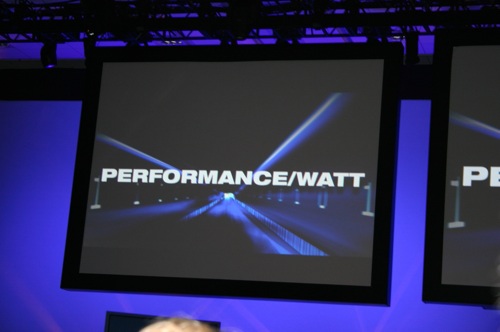
Intel's next microprocessor architecture will finally unify their desktop and mobile architectures, for a new focus on performance per watt as the driving force behind future CPU development.
Intel formally announced their first CPUs based on their next-generation microarchitecture: Woodcrest, Conroe and Merom. All of these CPUs will be built on a 65nm process and will be 64-bit enabled.
The new processors will be available in the 2H of 2006 and will significantly improve performance per watt over the current generation processors:
Woodcrest and Merom will both improve performance per watt by a factor of 3 over their predecessors.
Thanks to the death of NetBurst, Conroe will feature a 5x increase in performance per watt. Here's to the death of the power-hungry Intel processor.
Intel also set power consumption targets for the next-generation of systems based on these new 65nm processors:
On electrical cost savings alone, PC users will save $1 billion per year for every 100M computers.
The reduction in power will enable a new class of devices to be created at the 0.5W marker - the Handtop. The Handtop is basically a very small PC, that may end up being what everyone envisioned the Tablet PC as being.
Intel then went on to show off actual running silicon for all of their new CPUs, Conroe, Merom and Woodcrest.
Merom, a dual core mobile CPU, was running 64-bit Windows XP.
Intel had Conroe running a copy of Fedora Linux. Conroe is also a dual core product:
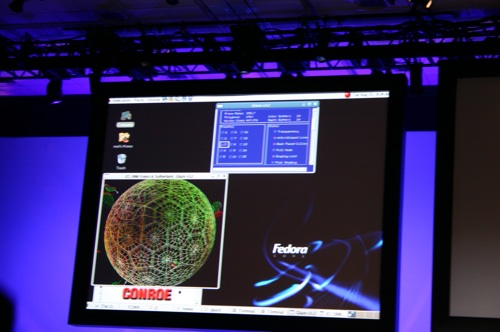
Intel's Woodcrest was running Windows Server 2003 in a DP configuration, with each processor featuring two cores:
We hope to have more information on Intel's new architecture as the week goes on, so stay tuned.


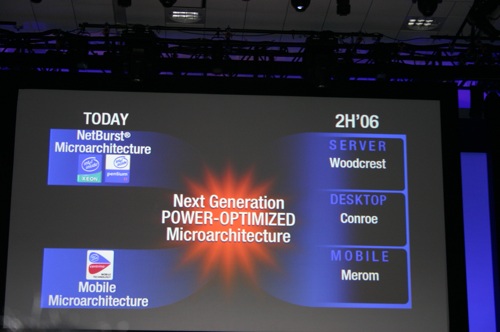
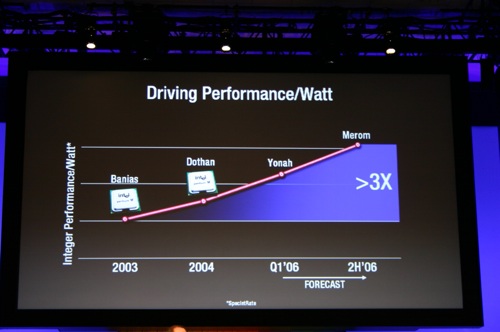
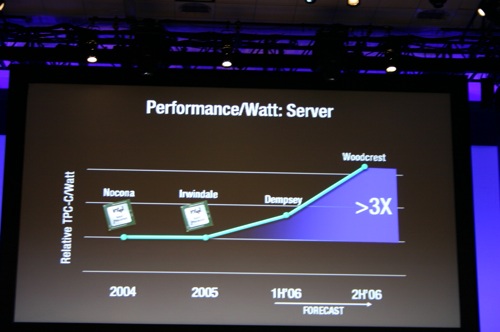


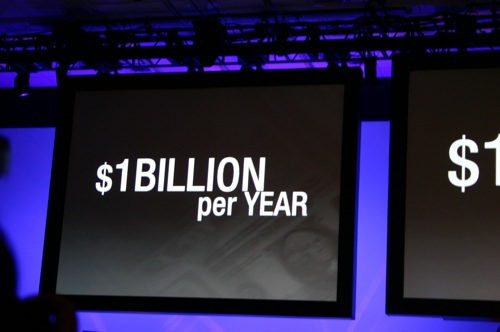
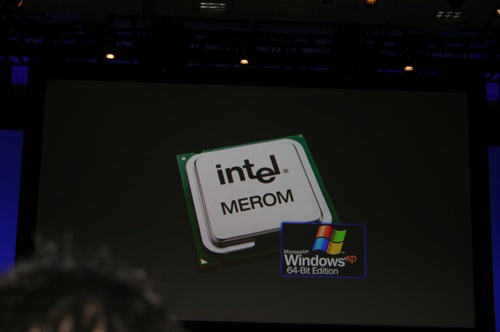
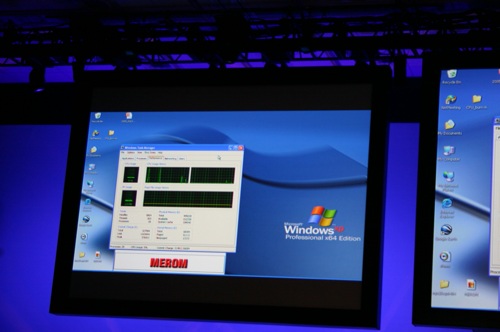
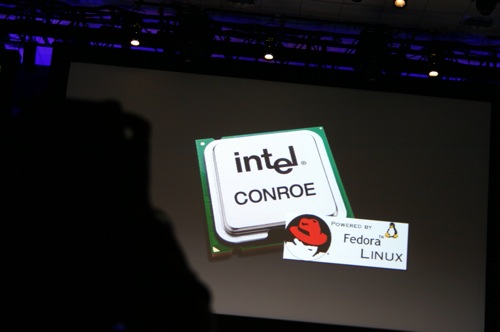
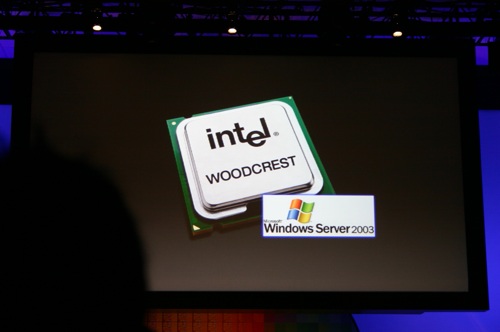
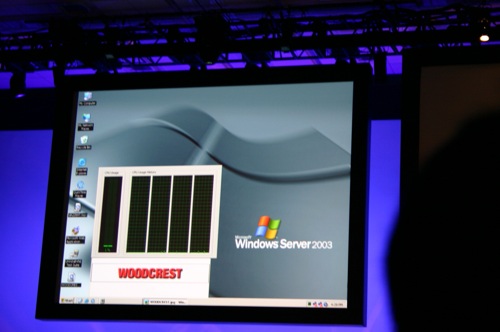








34 Comments
View All Comments
Leper Messiah - Tuesday, August 23, 2005 - link
Shens to no desktop purchases in the next 5 years. I personally plan on having a PC desktop in the next 5 years, and so does most of AT, i'm sure. Schools, businesses, etc., all will have desktops. So yeah.Anyone reminded of the IDF in 2000, when tejas was supposed to have us to 10GHz by now...Basically, I'll believe it when I see it.
bob661 - Tuesday, August 23, 2005 - link
I don't think they're giving that market away. I think Intel is saying that there won't be much money to be made in the desktop market after a while.
xbdestroya - Tuesday, August 23, 2005 - link
Are those future wattage estimates for processor alone, or total system expenditure? Because if it's CPU alone, 65 watts on the desktop is good - but it doesn't seem too mindblowing.xbdestroya - Tuesday, August 23, 2005 - link
I don't know, I think he whole 'per watt' angle is a good way to go, even on the desktop. A lot of people feel this will usher in an era of stylish, small, and quiet desktop PC's. As long as I can still buld my own, I'm all for it. Now then, on the other hand it's true that just because a chip has superior performance per watt, doesn't mean it has superior performance period.Matthew Daws - Tuesday, August 23, 2005 - link
It's interesting that for desktop CPU's they use "Integer" performance, while for servers they use "Relative TPC-C", i.e. a real-world database measurement. This could be nothing, but given that in the past the trend has been to push "media" performance, which generally means floating-point SIMD stuff, it's maybe a significant change. By which I mean: I would guess that this means 5x performance increase per watt doing some rather special, probably very heavy SIMD, integer work.As someone else said, it's odd that they are moving to "per watt" on desktop: it makes sense for laptops, and maybe for servers (heat and power are important) but on the desktop? It almost smacks of a new marketting angle: the new chips won't actually be measurably quicker than current ones, but will use a significant amount less power. Maybe good for business users, but not so great for the Anandtech market!
Jep4444 - Tuesday, August 23, 2005 - link
Does anyone else find this marketing direction(atleast for desktops and servers, it makes sense for laptops) is really stupid?Also i cant trust any diagram that depicts the Prescott as providing more performance per watt than the Northwood because anyone who knows anything about the Prescotts abnormal power requirements knows thats blatantly not true and also makes me highly skeptical about that 5x performance per watt number that Intel is giving
fishbits - Tuesday, August 23, 2005 - link
It doesn't matter. Intel can tell the true believers that it will be 5x as powerful and they'll believe it and buy it before bothering to verify the claims. Then if Intel doesn't live up to the promise, the fanbase will come up with excuses as to why that's no big deal. Me, I'd rather see real numbers from any CPU from Intel or AMD first, but you can already find folks swearing on their family's lives what the new Intel chips will be able to do, what the new ATI gpu will do, etc. It's a sickness, really."On electrical cost savings alone, PC users will save $1 billion per year for every 100M computers."
Ten whole dollars per year? Whoopdee doo!
Yes, lower power is better overall, but it's not the Alpha and Omega of processor value to me, especially in my hobbyist desktop. It just can't be "too hot" or draw "too much power." Hope Intel doesn't lose sight of this, although figuring out where to draw that line can be quite hard to do.
nullpointerus - Tuesday, August 23, 2005 - link
It occurred to me that they may be trying to capitalize on the U.S. fuel pseudocrisis. People will probably buy anything right now if you just tell them it's more efficient. Although, if you do the math (1.0 billion divided by 0.1 billion), Intel is only claiming to save people $10 per PC per year.erinlegault - Tuesday, August 23, 2005 - link
I can't believe anything Intel says at these IDF's.bob661 - Tuesday, August 23, 2005 - link
I just hope this "new" architecture performs better than what's available now.